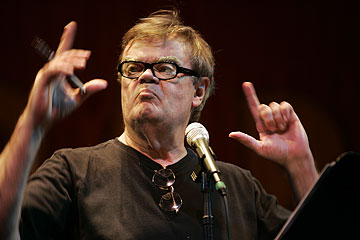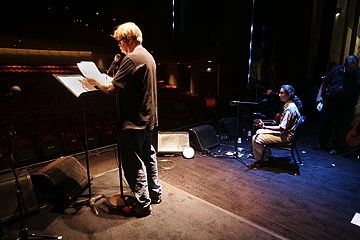Three hours before “A Prairie Home Companion” begins at the Blaisdell Concert Hall, Garrison Keillor starts to contemplate the 20-minute monologue he will deliver without notes on live radio to an audience of millions. Something about missionaries, he decides.
Did any missionaries come from Minnesota? “I don’t think so, but I’m going to invent some,” he says.

Garrison Keillor rehearses for “A Prairie Home Companion” performance
He doesn’t get more than a few minutes to work on it before he’s onstage testing a new song and tapping his famous red shoe to the slack-key guitar accompanying his melodic voice, followed quickly by a run-through of skits with the actors.
The night before, he wrote and produced until 10:30 p.m., then returned to the Sheraton Waikiki and worked until 2 a.m., leaving one to surmise that he doesn’t need much sleep.
“Well, I do, but I don’t get it,” he says, sipping from a Styrofoam cup of coffee that is rarely out of his hand during the intense two-day production he orchestrates 32 weeks a year.
Four minutes to air time: In honor of Veterans Day, Keillor coaches the audience to sing “Eternal Father, Strong to Save,” the Navy hymn he says will bring tears to the eyes of listeners, “especially those in the middle of cocktail hour on the East Coast.”
Show time: “Hello Minnesota, everyone!” Keillor sings. “We’re out here in Hawaii, and it’s no fun. Volcanoes overflow and the typhoon’s about to blow. How we’ll survive, we don’t know!” The crowd erupts.
But what is really involved in assembling a performance of this magnitude, before the audience sits down and tunes in?
On Friday, 30 hours before airtime, the crew works among cases, speakers, amplifiers and massive digital sound-mixing consoles — mostly in the dark, because the lighting director is trying to position the spotlights.
Keillor remains sequestered in his hotel room, writing and rewriting, says Judy Neale, director of promotion for Hawaii Public Radio. “I’ve never heard of him going out. He’s unbelievable.”

With 25 hours left, the Steinway D Series Concert Grand Piano arrives. Rolled under protective cloths, it will become the centerpiece. The model house that’s usually on stage did not get shipped across the ocean. Too expensive. But the hanging “Rhubarb” signs made it, and serve as a colorful backdrop.
Conversations revolve around wires and splitters and adaptors. Broadcast engineer Sam Hudson hooks up dozens of cables in a variety of colors near a cluster of 25 standing microphones of all shapes and sizes.
Hudson mentions that he is also the talent producer. “We all wear about six hats, so you can call us anything you want,” he says.
“We have six people; most other shows have 20,” adds Thomas Scheuzger. “Seriously, we have one truck; the Rolling Stones have 70.”
Traveling lighting director Janis Kaiser takes a break to explain her job. “If you say lighting for a radio show, people are generally amused by that,” she says. But guiding the audience’s attention in the proper direction is essential to the flow and sound of the show.
She stops talking and eyes the manapua in her hand. “This is a new experience,” she says. What, no manapua in her home state of Connecticut? “No,” she laughs. “I may be hooked.”
With 22 hours remaining, Patrick Cockett and Pancho Graham from the Hawaiian musical group Na Pali arrive from Kauai with Graham’s bass in tow. They played on “A Prairie Home Companion” in 1985 with Taj Mahal before touring Europe and the United States with the legendary musician.
At the time, Cockett says he didn’t know who Garrison Keillor was, but figured it out the next week when Keillor was on the cover of Time Magazine.
“He’s out of the blue,” Cockett says, describing how Keillor sketches the show and often does what he pleases along the way as supporting players try to keep up. But what Cockett remembers most from his experience two decades earlier was Keillor’s masterful rapport with the audience. “He had them singing really beautifully.”
Na Pali musician and University of Hawaii professor Carlos Andrade agrees. “He’s very professional, but yet he’s very casual in the sense that he’s easy to talk to. He connects really well with whoever he works with, and he’s got a great sense of humor.”
With 21 hours to go, the red shoes appear for the first time. Dressed in baggy jeans and a navy blue T-shirt, Keillor strolls into the makeshift production office just off stage right and sets his laptop on the folding table next to copy machines. He taps away on his computer as his foot moves to the beat of The Guy’s All-Star Shoe Band’s bluegrass tunes.
Though he engages in no small talk, Keillor seems unperturbed by mountains of distractions — something he’s no doubt learned to manage since he started the show in 1974.
In addition to the radio shows, there are books, articles, columns and speeches to compose. His staff confirms that he wakes up early and writes on planes and in cars. All agree that he has a photographic memory.
With 20 hours remaining, the actors arrive. As soon as the script — a draft, they know — comes off the copier, Sue Scott, Tim Russell and Fred Newman plant themselves at separate tables backstage and begin reading aloud, highlighting, making notes, altering facial expressions, experimenting with different voices.
When asked how many voices he can produce, 12-year “Prairie Home Companion” veteran actor Russell says, “Oh, I have no idea.”
Sound effects master Fred Newman is especially loud, blowing into his hand, creating a snowplow. He looks up, smiles and says, “Sorry.” Ten seconds later the air is broken again as his hand vibrates over his throat while he screeches, crushes plastic plates, drops CD cases, kneads a bag of gravel and massages discarded plastic wrap, wondering aloud if it mimics walking through the brush — all in an effort to identify the right effect Keillor’s script requires.
A minor problem: The sound effects props didn’t make it to Hawaii, prompting a Wal-Mart shopping spree and a flurry of innovation. And could he borrow a writer’s shoes to hear if they make a good walking sound?
They read through the scripts the night before so Keillor can hear the writing. But when does he manage the edits?
Russell shrugs. “In the middle of the night? After all these years, I still don’t know how the wheels work.” He shakes his head. “It’s pure genius.”
Sue Scott, who has played numerous characters on the show since 1992, adds, “He’s a maniac; he’s so prolific. We’ve worked with him all these years, and we don’t know when he sleeps. He’s just focused, and somehow it all gets done.”
Both Russell and Scott confirm that the creative process continues during a performance, and that Keillor sometimes makes adjustments “on the fly,” within 15 to 20 seconds during a live broadcast.
“We’re ready to spin on a dime,” says Scott.
With 19 hours left, Luana McKenney, Mihana Souza and Aima McManus of Puamana rehearse the numbers they will perform — 21 years after their first appearance on the show with their mother Auntie Irmgard Aluli.
Luckily, we weren’t doing a wedding, because we would never leave a bride,” says McManus. “It was just meant to be.”
On Saturday, the crew arrives before 7 a.m. With 90 minutes until show time, Keillor rehearses with the actors, completing a poetic, hilarious commercial about a herd of greedy people rushing through a buffet line. Then he stops abruptly and says to nobody in particular, “and I have to rewrite the last verse.” To Newman he says, “I’m going to give you a little window to do the sounds of food and stampede and mastication.”
There are also brief instructions to his band about taking “the biscuit thing and twisting it toward the blues.”
Watching him ease between writing, singing, composing and producing as he constructs the show with moments to spare is to witness astonishing talent at work.
With 55 minutes remaining, Keillor is back at his perch at the folding table just off the stage, writing. His computer freezes; he calmly reboots. He’s still not dressed in his suit. The musicians hover, awaiting instructions.
“Danny’s only finding out now what he’s going to play,” says Gene Carvalho, Danny’s father. “It’s really ’seat of your pants.’” He gestures toward Keillor. “He’s creating the show right now!”
In addition to the music, there’s a Guy Noir skit about a newlywed who comes to Hawaii for his honeymoon and never returns to Minnesota, a reference to cows wearing grass skirts called moo moos and an amusing piece about scandalized preachers who try to abolish hula.
At the end of the two hours, Keillor, along with cast, crew, band and the warmly received guest artists, earn a standing ovation for their efforts.
Pure genius, indeed.
Sidebar: Listeners to get second dose of Hawaii
For the first time since “A Prairie Home Companion” visited Hawaii in 2002, Honolulu residents were treated to a double dose of the iconic radio variety show yesterday at Blaisdell Concert Hall, after American Public Media and Garrison Keillor decided to create two entirely different programs for broadcast. Tickets for both disappeared quickly.
The first show at 1 p.m. was broadcast live on National Public Radio. The second was recorded and will air in early January “when people really need it,” says Keillor, no doubt conjuring images of Midwesterners listening to 16-year-old Danny Carvalho’s lyrical slack-key guitar music as they contemplate shoveling their walkways free of snow.
But this also meant that Keillor had to write two two-hour radio programs, with different skits, commercials, songs and fresh 20-minute monologues, leaving no time for the beach before he heads back to St. Paul, Minn., today.
Of 32 live shows a year, half are performed on the road. The other 16 are done in St. Paul, Minneapolis or New York.
Featured Hawaii musicians included Carlos Andrade, Pat Cockett, Fred Lunt, Pancho Graham, Danny Carvalho, Owana Salazar, Luana McKenney, Mihana Souza and Aima McManus.